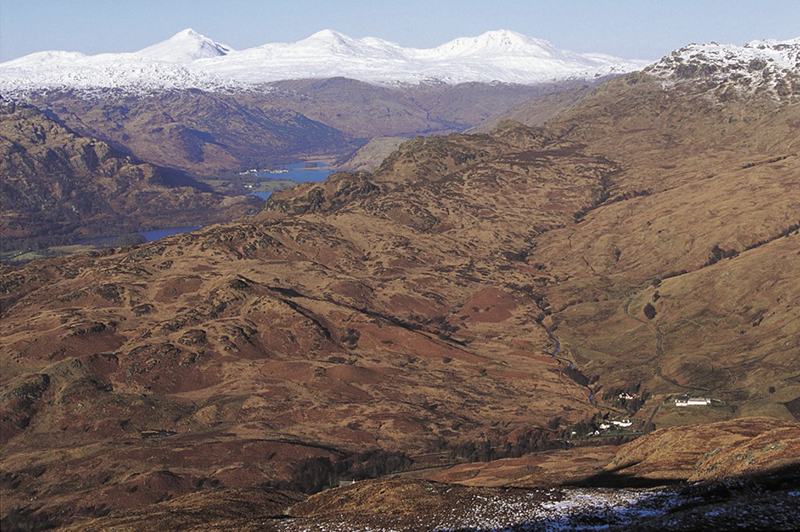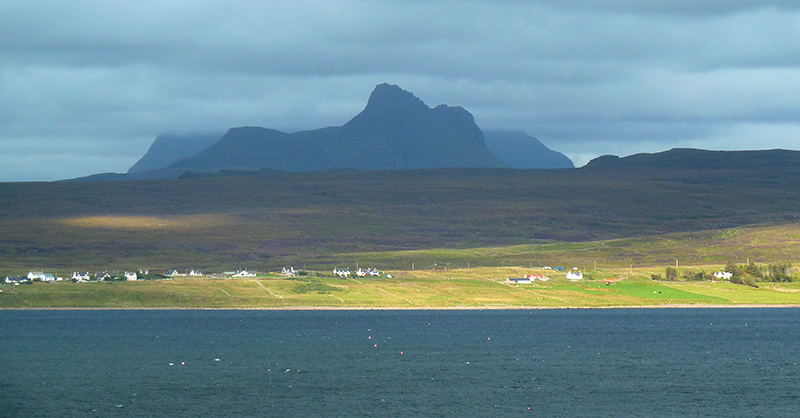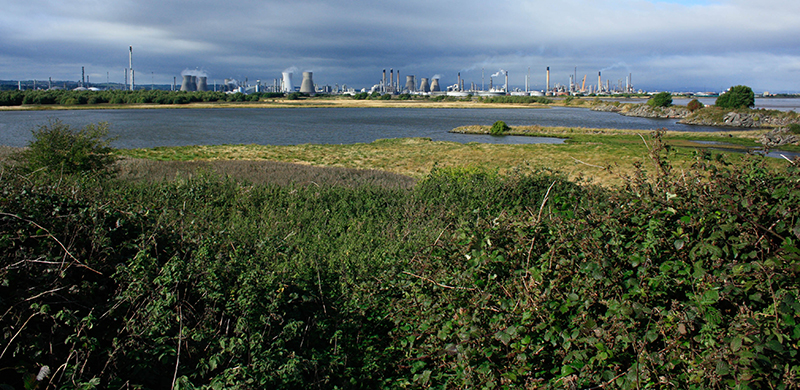“The future of landscape-scale conservation is not just about delivering more, bigger, better and joined up nature reserves. It is also about winning hearts and minds.” Sir John Lawton
Landscape-scale conservation involves working in collaboration at a big scale to deliver more benefits for the environment and people. Find out more about this conservation approach, how others have been delivering it and where you can go for further information, expertise and inspiration.
Inversnaid RSPB Reserve - © Andy Hay (rspb-images.com)
What is Landscape-Scale Conservation?
Landscape-scale conservation - (also known as ecosystem approach) is land management that involves working in collaboration and working at a large scale - often around a catchment, estuary or other recognisable landscape unit. This is a scale at which natural systems tend to work best and where there is often most opportunity to deliver real and lasting benefits. In this way, it is possible to deliver environmental, social and economic benefits that are more difficult to achieve by managing small sites individually. Collaborating across landscapes means land managers (public, private or third sector) can achieve greater success than working in isolation.
Coigach seascape - © Derek Christie
Landscape-scale conservation aims to:
- Increase the quality and area of natural and semi-natural habitats
- improve functional links between habitats so they are more resilient to environmental change
- enhance other ecosystem characteristics.
This means that as well as benefiting nature itself, it is a way of building Scotland’s natural capital and the range of benefits this gives to people.
Why do we need Landscape-Scale Conservation?
Globally, natural systems are under pressure and a more concerted and integrated response is required. Nature provides us, as individuals and society, with a wide range of life-sustaining services and benefits that we all depend upon, and these are being eroded.
There are significant limitations in what can be achieved in protecting individual sites, in the face of the range of pressures affecting nature. These sites are often too small and isolated to reduce wider biodiversity declines on their own.
Landscape-scale approaches to conservation, and the development of green infrastructure, are important solutions to this problem. They create habitat networks and corridors to connect and strengthen existing habitats, nature conservation sites and protected areas, enhancing and expanding them where necessary.
Kinneil Lagoons, Inner Forth - © Ian Kirkman
How can Landscape-Scale Conservation be delivered?
Policy
- The Scottish Government planning policy - gives support for the greater connectivity of habitats, and contains proposals to maximise the benefits of green infrastructure.
- 2020 Challenge for Scotland’s Biodiversity - promotes an ecosystem approach to biodiversity conservation and restoration, which includes the need to take an integrated, landscape-scale approach.
- Scotland’s second Land Use Strategy (2016-2021) - highlights that maximising the benefits provided by nature often requires co-ordinated action at a landscape scale.
Best practice
In March 2015, over 150 practitioners from across Europe came together at a workshop in Bristol, UK, to form a “Super Brain”. This was tasked with tackling some of the most important challenges for landscape-scale conservation today.
The result was a recipe for success: a guide to developing landscape-scale conservation arranged around five broad themes:
- Engaging
- planning
- doing
- evaluating
- sustaining.
The recipe reflects the experience of many landscape-scale conservation initiatives and partnerships.
Funding
Bigger - undertake a significant extent and degree of management of the natural ecosystem as part of an agreed and balanced package of ecosystem services and land uses.
Better - have a long term vision, and seek active engagement and participation from a wide range of stakeholders in both the planning and delivery of the project.
Joined up - practice integrated planning and management across a large contiguous area, developing habitat networks, stepping stone corridors and restoration areas, which all help to reduce habitat fragmentation.
- Forestry Co-operation - grants to encourage landscape-scale collaborative forestry projects between two or more landowners by providing support for project facilitation and co-ordination. The subsequent management activity can be supported through other options within the Forestry Grant Scheme.
Guidance
- Landscape Character Assessments - NatureScot has mapped and described the variety of landscapes found throughout Scotland. Highlighted for use in the UK Forestry Standard and Scottish Forestry Strategy to integrate forestry into Scotland’s variety of landscapes
- Historic Land-Use Assessments - an interactive map showing historic land-use patterns, describing them by period, form and function. It aims to enhance knowledge and understanding of the historic landscape and to inform land management decisions relating to it.
Where is Landscape-Scale Conservation happening?
Across Scotland, partnerships are delivering landscape scale conservation projects with many different challenges and opportunities. The map below shows how these projects cut across many different boundaries and focus action.
Explore the case studies below or click on the map labels to find out how partnerships have worked at a landscape scale to overcome a variety of challenges and deliver some impressive conservation and community benefits. If you would like to submit a case study to this list please contact zoe.clelland@rspb.org.uk
Case studies
- Coigach Assynt Living Landscape
- Cumbernauld Living Landscape
- East Ayrshire Coalfield Environment Initiative
- Inner Forth Futurescape
- Strathard Initiative
- The Great Trossachs Forest
If you would like to get involved or find out more about these projects, you can find a full list of contact details for the case studies Case Studies - Contacts list.
Who can help?
At a Sharing Good Practice event in September 2013 organised by RSPB Scotland, NatureScot and Forestry Commission Scotland, participants called for greater collaboration and sharing of good practice, which led to formation of the landscape-scale conservation working group.
Landscape-scale conservation working group - is part of the Scottish biodiversity strategy and focussed on coordinating ways to help promote good practice on the ground and ensure practical experience informs policy. The group includes representation from:
Forestry Commission Scotland - advises and implements forestry policy to protect and expand Scotland's forests and to increase their value to society and the environment.
NatureScot - works to care for natural heritage, enabling people to enjoy it, helping people to understand and appreciate it, and supporting those who manage it.
Scottish Wildlife Trust – is working to create a network of healthy, resilient ecosystems to support expanding communities of native species across large areas of Scotland's land, water and seas.
South Lanarkshire Council - co-ordinates the Local Biodiversity Action Plan and has adopted an ecosystem and partnership based approach to protecting and improving South Lanarkshire’s natural environment, landscapes and wildlife.
The Scottish Government - has a range of responsibilities under devolution, including the environment. Detailed policies, as set out in the Scottish Biodiversity Strategy and the Land Use Strategy 2016-2021 support a landscape scale approach.
Scottish Environment Protection Agency - is making sure that the environment and human health are protected, and ensuring that Scotland’s natural resources and services are used as sustainably as possible and contribute to sustainable economic growth, through environmental regulation, river basin and flood risk management planning and flood warning.
RSPB Scotland – is making nature reserves and protected areas the best they can be for nature, as well as working in partnership through Futurescapes, to make landscapes across the UK more wildlife-friendly.
If you would like to find out more about the landscape-scale conservation working group contact zoe.clelland@rspb.org.uk
Landscape-scale conservation practitioners network
There are people across Scotland involved in a multitude of landscape-scale conservation projects, from reforesting or rewetting some of our wildest landscapes to bringing nature and natural processes back into our urban areas. A network of these people holds great potential to learn more about how to deliver good projects, understand what’s possible and be inspired to take forward new ideas. Please join and share what you know.
A Landscape-Scale Conservation Practitioners Event was held simultaneously in two locations, Glen Finglas and Tomintoul, on 1st November 2017. Over 40 LSC Practitioners from around Scotland attended. The purpose of this event was to:
- facilitate networking amongst landscape-scale conservation practitioners
- provide case studies/site visits of successful LSC projects
- develop the scope of the Practitioner’s Network and plan future activities.
A summary report from the events is available for download Landscape-Scale Conservation - Practitioners Event (PDF).
If you are involved in landscape-scale conservation, please join our practitioners’ network and share your knowledge and experience.
- Become a member of the network via our Linked In group contact zoe.clelland@rspb.org.uk
- Join the Twitter conversation using #landscapescale
If have any suggestions on information, guidance, useful contacts, and events to share, or have a question to ask the landscape-scale conservation working group and practitioners network – please get in touch - your feedback is always welcome.
This page was updated on 27 Nov 2019
Adobe Acrobat Reader is the free, trusted leader for reliably viewing, annotating and signing PDFs.
Download Adobe Acrobat Reader




